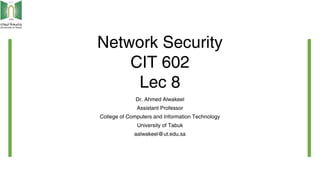
Lec 8.pptx.pdf
- 1. Network Security CIT 602 Lec 8 Dr. Ahmed Alwakeel Assistant Professor College of Computers and Information Technology University of Tabuk aalwakeel@ut.edu.sa
- 2. S/MIME Secure/Multipurpose Internet Mail Extension S/MIME is a security enhancement to the MIME Internet e-mail format standard based on technology from RSA Data Security. It appears likely that S/MIME will emerge as the industry standard for commercial and organizational use, while PGP will remain the choice for personal e-mail security for many users. we need first to have a general understanding of the underlying e-mail format that it uses, namely MIME. But to understand the significance of MIME, we need to go back to the traditional e-mail format standard, RFC 822, which is still in common use. Dr. Anas Bushnag 2
- 3. RFC 5322 It defines a format for text messages that are sent using electronic mail. It has been the standard for Internet-based text mail messages and remains in common use. In the RFC 5322 context, messages are viewed as having an envelope and contents. The envelope contains whatever information is needed to accomplish transmission and delivery. The contents compose the object to be delivered to the recipient. Dr. Anas Bushnag 3
- 4. RFC 5322 The RFC 5322 standard applies only to the contents. However, the content standard includes a set of header fields that may be used by the mail system to create the envelope. A message consists of some number of header lines (the header) followed by unrestricted text (the body). The header is separated from the body by a blank line. Another field that is commonly found in RFC 5322 headers is Message-ID. This field contains a unique identifier associated with this message. Dr. Anas Bushnag 4
- 5. RFC 5322 Dr. Anas Bushnag 5
- 6. Multipurpose Internet Mail Extensions (MIME) It is an extension to the RFC 5322 framework that is intended to address some of the problems and limitations of the use of Simple Mail Transfer Protocol (SMTP): 1. SMTP cannot transmit executable files or other binary objects. 2. SMTP cannot transmit text data that includes national language characters, because these are represented by 8-bit codes with values of 128 decimal or higher, and SMTP is limited to 7-bit ASCII. 3. SMTP servers may reject mail message over a certain size. Dr. Anas Bushnag 6
- 7. Multipurpose Internet Mail Extensions (MIME) The MIME specification includes the following elements: 1. Five new message header fields are defined. 2. A number of content formats are defined. 3. Transfer encodings are defined that enable the conversion of any content format into a form that is protected from alteration by the mail system. Dr. Anas Bushnag 7
- 8. Multipurpose Internet Mail Extensions (MIME) The five header fields defined in MIME are: 1. MIME-Version: Must have the parameter value 1.0. 2. Content-Type: Describes the data contained in the body with sufficient detail that the receiving user agent can pick an appropriate agent or mechanism to represent the data to the user 3. Content-Transfer-Encoding: Indicates the type of transformation that has been used to represent the body of the message in a way that is acceptable for mail transport. Dr. Anas Bushnag 8
- 9. Multipurpose Internet Mail Extensions (MIME) 4. Content-ID: Used to identify MIME entities uniquely in multiple contexts. 5. Content-Description: A text description of the object with the body; this is useful when the object is not readable (e.g., audio data). Dr. Anas Bushnag 9
- 10. Multipurpose Internet Mail Extensions (MIME) Dr. Anas Bushnag 10
- 11. S/MIME S/MIME is very similar to PGP. Both offer the ability to sign and/or encrypt messages. S/MIME provides the following functions: 1. Enveloped data: This consists of encrypted content of any type and encrypted content encryption keys for one or more recipients. 2. Signed data: A digital signature is formed by taking the message digest of the content to be signed and then encrypting that with the private key of the signer. The content plus signature are then encoded using base64 encoding. A signed data message can only be viewed by a recipient with S/MIME capability. Dr. Anas Bushnag 11
- 12. S/MIME 3. Clear-signed data: As with signed data, a digital signature of the content is formed. However, in this case, only the digital signature is encoded using base64. As a result, recipients without S/MIME capability can view the message content, although they cannot verify the signature. 4. Signed and enveloped data: Signed-only and encrypted-only entities may be nested, so that encrypted data may be signed and signed data or clear-signed data may be encrypted. Dr. Anas Bushnag 12
- 13. S/MIME To specify the requirement level: 1. MUST: An implementation must include this feature or function. 2. SHOULD: It is recommended that an implementation include the feature or function. Dr. Anas Bushnag 13
- 14. S/MIME Dr. Anas Bushnag 14
- 15. S/MIME S/MIME secures a MIME entity with a signature, encryption, or both. The use of transfer encoding requires special attention. For most cases, the result of applying the security algorithm will be to produce an object that is partially or totally represented in arbitrary binary data. This will then be wrapped in an outer MIME message, and transfer encoding can be applied at that point, typically base64. Dr. Anas Bushnag 15